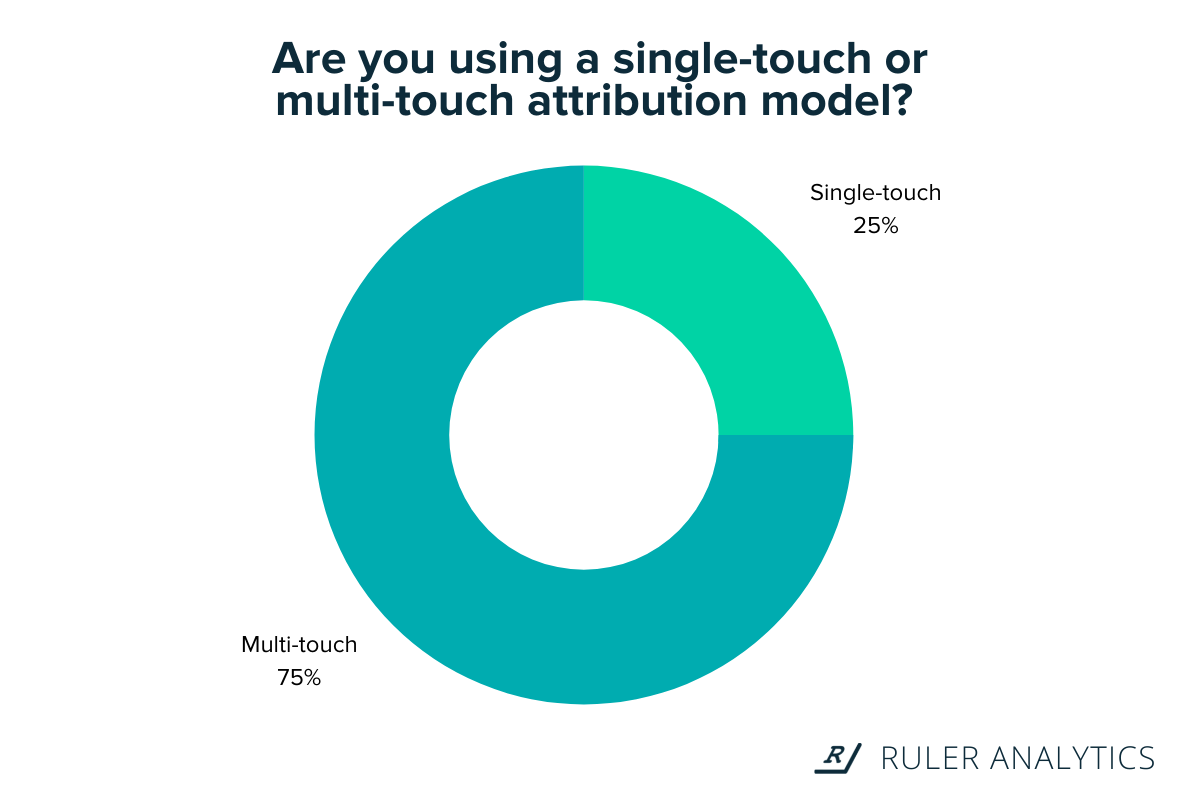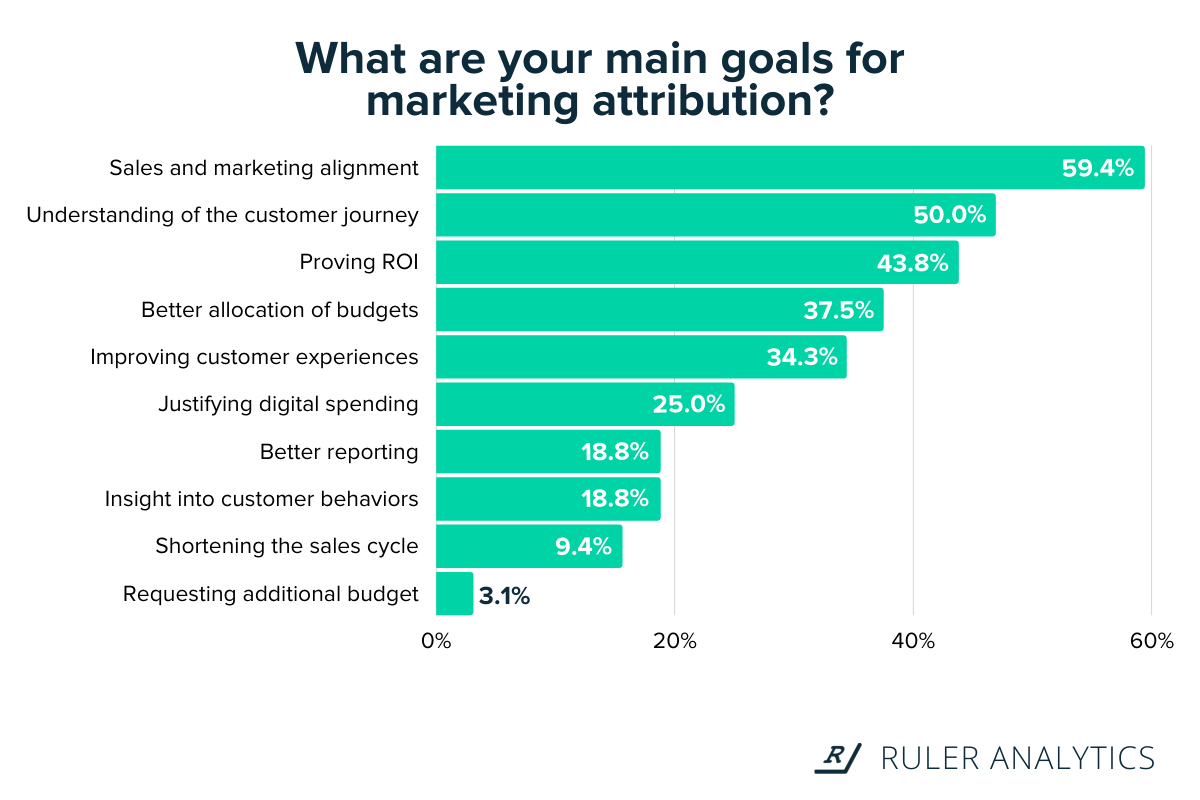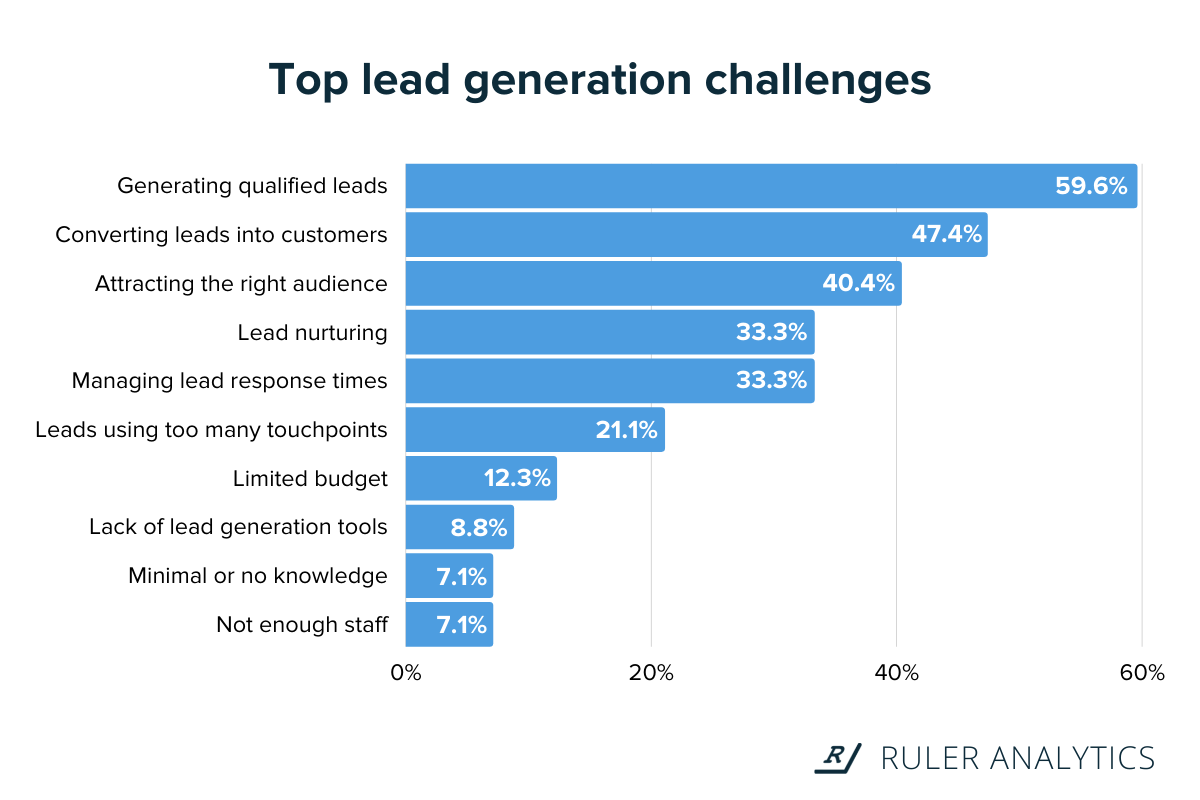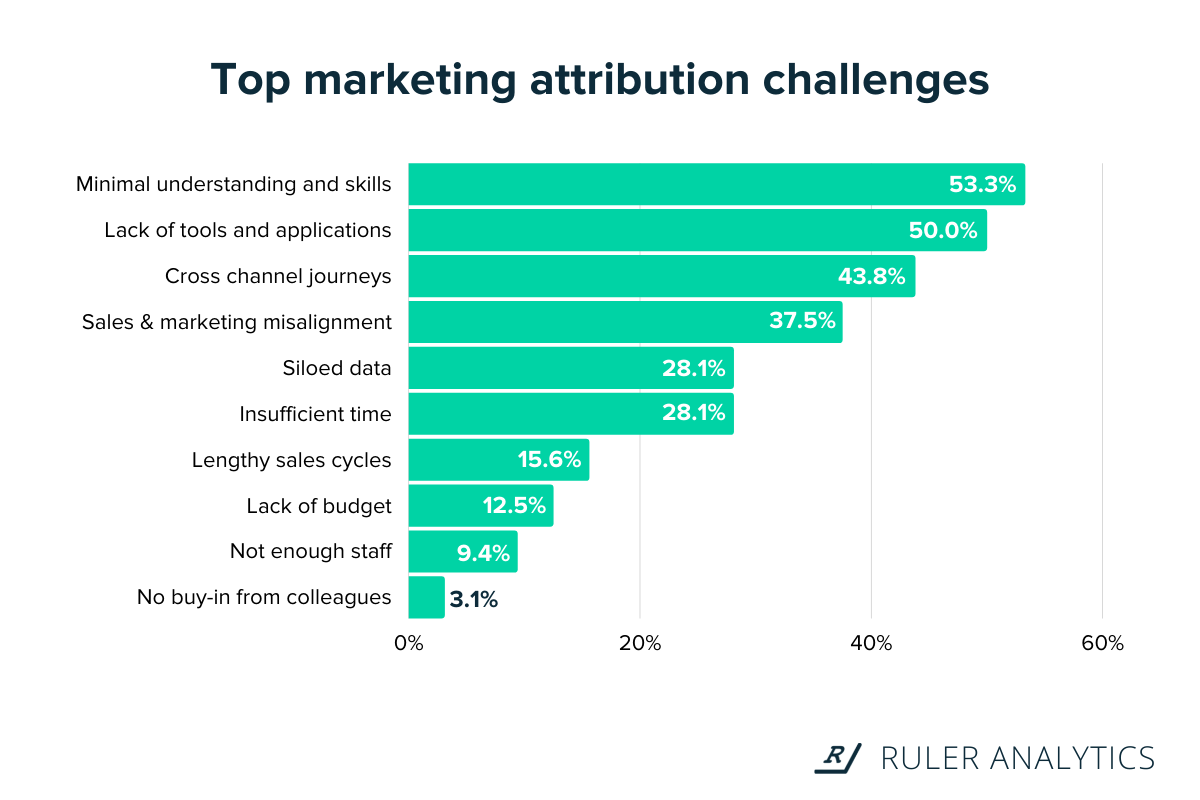These marketing attribution statistics are designed to guide you towards new opportunities that will help drive more meaningful results for your business.
Marketing attribution is constantly evolving, and it’s important that you don’t get left behind.
As a provider of multi-touch marketing attribution, we decided to compile a list of the best marketing attribution statistics to help you stay ahead of the curve while making smarter decisions about your sales and marketing performance.
Let’s not waste any more time and get stuck in.
💡 Pro Tip
Want more mind-blowing statistics on marketing attribution? Get your copy of the marketing attribution analysis to unlock key challenges and insights to enhance your attribution reports.
Download the marketing attribution and analysis report
The purpose of attribution modelling is to gain a better understanding of how different channels contribute to your marketing ROI. With the insights below, you can start building better attribution reports for your company and get the credit you truly deserve.
1. 76% of all marketers say they currently have, or will have in the next 12 months, the capability to use marketing attribution (Source: Think with Google)
Marketing attribution is probably one of the most talked about topics in digital and the least understood. Fortunately, data suggests that more marketers are recognising the importance of attribution and becoming better equipped when assigning credit to the right marketing channels.
2. 75% of companies are using a multi-touch attribution model to measure marketing performance (Source: Ruler Analytics)
Single-touch models were once an effective way to attribute credit and revenue. When the customer journey was less complicated, and buyers relied solely on salespeople for product information. Those days, however, are long gone. Today’s buyers will use more touchpoints to independently seek out information about a company before engaging with a sales rep. With that in mind, modern marketers are moving towards multi-touch attribution models to gain a better view of the customer journey.

3. 57.9% of marketers use a marketing attribution tool (Source: Ruler Analytics)
Marketing attribution software is a must-have for modern companies, and yet nearly half of marketers do not have a solution in place. Despite the upfront cost of many attribution tools, they are designed to save you money by identifying the lead generation techniques that are having the greatest impact on your bottom line.
💡 Pro Tip
Looking for a marketing attribution tool but don’t know where to start? Check out our shortlist of the best marketing attribution tools and find the perfect solution for you and your team.
4. 53.5% say that the last-touch attribution model is somewhat effective (Source: Ruler Analytics)
Last-touch attribution is pretty straightforward and works well for businesses that generally have shorter sales cycles. On the other hand, last-touch attribution doesn’t value earlier touchpoints in your funnel, which may have been pivotal to the customer journey.
5. 41% of marketers are most commonly using the “last-touch” method for their online attribution (Source: Digiday)
According to a study by Digiday, respondents agreed that last-touch was their most commonly used attribution method. This doesn’t come as a surprise, as tools like Google Analytics by default make use of the last non-direct click attribution model.
6. 44% say that a “first-touch” model is more useful for measuring digital campaigns (Digiday)
In the same study, nearly half of marketers claimed the first-touch attribution model to be more effective for measuring digital campaigns. Similar to last-touch, this attribution model is overly simplistic and works best for companies that have fewer interactions with users throughout the customer journey.
Marketing attribution offers a series of benefits, from better decision making power to a greater view of the full customer journey.
7. 84% of marketers are confident that marketing impacts revenue and sales (Source: Ruler Analytics)
While the majority of marketers are satisfied with the value of their campaigns, only 60% are confident they’re able to demonstrate ROI.
8. Optimising the customer journey across multiple touch points is viewed “very important” by 71% of marketers (Source: Adobe)
These marketers are right to regard optimising the customer journey as a top priority. Analysing and developing the customer journey over multiple touchpoints allows you to make sense of the channels that have the greatest impact on your bottom line, allowing you to cut back on underperforming campaigns that aren’t pulling their weight.
💡 Pro Tip
Want greater visibility over your customer journey? Get our guide on how to track customer journeys and monitor how your leads move from the awareness to the decision stage.
Download the guide on tracking customer touchpoints
9. 59.4% agree that sales and marketing alignment is the main goal of marketing attribution (Source: Ruler Analytics)
Sales and marketing alignment, or smarketing, is possibly the greatest opportunity for successful marketing attribution. When sales and marketing unite as one, both teams share the same goals and can focus on driving the right type of leads that convert at a much lower cost.

10. 40% of marketers believe that more accurate data would improve reporting efficiency (Source: Ruler Analytics)
With the customer journey getting more complicated, there’s an increased demand for better and actionable insight. The more data marketers have, the easier it is to accomplish goals and revenue targets.
11. Attribution across your multitude of marketing channels can provide efficiency gains of 15-30% (Source: Zoominfo)
If you’re not using multi-channel attribution, then it’s likely you’re missing out on potential revenue gains.
12. The average conversion rate for email marketing is 3.9% (Source: Ruler Analytics)
Data suggests that industrial (7.4%), B2B services (5.9%), finance (5.8%) and professional services (5.1%) come out on top for having the highest average conversion rates, whereas real estate (1.3%) and automotive (0.8%) have the lowest rates.
13. The average conversion rate for organic search is 5.0% (Source: Ruler Analytics)
Professional services (12.3%), industrial (8.5%) and B2B services (7.0%) sweep the board for having the highest conversion rates, whereas B2B tech (1.0%), B2B eCommerce (3.5%) and travel (3.5%) fall to the bottom of the pack.
14. The average conversion rate for paid search is 3.6% (Source: Ruler Analytics)
Professional services (7.0%) came out on top for having the highest average conversion rate, closely followed by agency (6.6%) and finance (6.0%). automotive (1.3%), real estate (1.5%) and B2C eCommerce (1.8%) delivered the lowest average conversion rates.
15. The average conversion rate for referral is 4.1% (Source: Ruler Analytics)
Interestingly, travel (9.5%) had the highest average conversion rate. Finance (7.1%) and healthcare (7.1%) came in second, while automotive (1.3%) and real estate (1.5%) both displayed lower conversion rates.
16. The average conversion rate for social media is 1.9% (Source: Ruler Analytics)
Performance is low across the board, although we found that professional services (4.0%), healthcare (3.1%) and automotive (2.9%) had the highest conversion rates compared with other industries.
💡 Pro Tip
Access the conversion benchmark report and get more statistics, trends and observations across 14 industries and gain valuable insights to maximise your lead quality.
Download the conversion benchmark report
While marketing attribution can offer many opportunities, there are a host of challenges that can arise without proper strategy and tools set in place.
17. 100% of marketers say they have trouble tracking television or radio ads (Source: Ruler Analytics)
Contrary to what many might think, traditional advertising still has its place and is a viable route to revenue if done right. In fact, TV ad spending in the US is set to bounce back this year and increase by 33.1% to $2.85 billion.
18. 70% of businesses are now struggling to act on the insights they gain from attribution (Source: AdRoll)
You can have all the data in the world, but if you can’t turn it into information, it’s useless. Marketer’s need to explain what numbers mean in order to justify spending and demonstrate value. For example, reporting that “Google Ads generated £100k revenue” is a lot more effective than “we increased conversions by 50%”.
19. 62% of marketers are failing to attribute revenue to inbound calls (Source: Ruler Analytics)
Phone calls remain one of the most powerful lead generation techniques. In fact, phone calls are 10-15 times more likely to convert than inbound web leads. Many marketers, however, don’t have access to this level of insight as they lack the right technology to measure inbound quality.
💡 Pro Tip
Without call tracking, you’re potentially underestimating—or overestimating—the effectiveness of your marketing performance. Get your copy of the offline conversion tracking eBook and see which marketing sources, keywords and ads are driving the most offline interactions.
Download the guide on offline conversion tracking
20. 59.6% ranked “generating qualified leads” the top lead generation challenge (Source: Ruler Analytics)
Quality leads are the lifeblood of almost every business, but they appear to be a widespread challenge across many teams. Typically, sales and marketing teams will focus on getting as many leads as possible in order to grow the bottom line. But that’s the problem. More leads don’t equal more revenue. Focusing on the volume of leads may seem like the right approach. But more often than not, this method overwhelms the pipeline and causes the sales teams to overlook legitimate opportunities.

21. 53.3% say a minimal understanding is the main challenge of effective marketing attribution (Source: Ruler Analytics)
While there are plenty of tools out there that can help, technology alone can’t solve the marketing attribution enigma. Traditional methods of marketing attribution require a lot of technical experience and a certain set of skills to succeed.

22. 53% of marketers are struggling to track and attribute live chat conversions (Source: Ruler Analytics)
Live chat plays an integral part in lead generation by allowing sales and marketing teams to target, communicate and convert prospects in real-time. In a recent study, however, we discovered that over half of marketers are failing to attribute sales and revenue activity back to live chat conversions.
💡 Pro Tip
Download our guide on tracking live chat and identify which channels, campaigns and keywords generate the most valuable live chat conversions and make informed decisions to drive more qualified leads and sales.
23. 42% of marketers report attribution manually using spreadsheets (Source: econsultancy)
While there’s nothing inherently wrong with spreadsheets, there are more reliable ways to collect, analyse and manage lead and sales data. A CRM, for instance, allows you to take a deeper dive into your customer data, allowing you to keep on top of key relationships and make smarter decisions to boost ROI. Fortunately, more marketers are making the switch from spreadsheets to the CRM. During a survey, nearly 70% of marketers said they use a CRM to store key lead generation data.
24. Only 39% of companies are carrying out attribution on ‘all or most’ of their marketing activities (Source: econsultancy)
This figure has climbed from 31% in the last year. A clear indication that companies are investing more time and resources in marketing attribution. On the other hand, this figure is still low when you consider the number of tools and processes widely available to marketers.
While these challenges may have left you feeling a little apprehensive about marketing attribution, there are solutions out there that you can use to overcome most of these common obstacles.
For example, Ruler is a marketing attribution solution for phone calls, forms and live chat, evidencing every step a visitor makes in their journey and matches revenue to the source.
Ruler provides a single point of truth, allowing marketers to easily track and attribute revenue to the conversations that happen away from the website, such as phone calls and live chat enquiries.
The best thing about Ruler is that it automatically sends attribution data to your CRM and the marketing tools you use every day.
Not only do you require minimal technical expertise, but there’s no longer a need to shift through endless spreadsheets to attribute value back to your marketing tactics.
Sounds good, right?
We think so too.
You can download the eBook to learn more about how Ruler works. Or, you can get more information via our blog on how Ruler can attribute revenue to your marketing.
There you have it.
Hopefully, this list of statistics has inspired you, and you’re feeling better equipped to tackle marketing attribution head-on.
Don’t forget to check out our marketing attribution analysis report for even more mind-blowing stats and insights.
And if you liked this article, make sure to sign up to our newsletter for more related updates on marketing attribution.
This article was originally published in July 2021 and was last updated on 26th April 2022 for freshness.